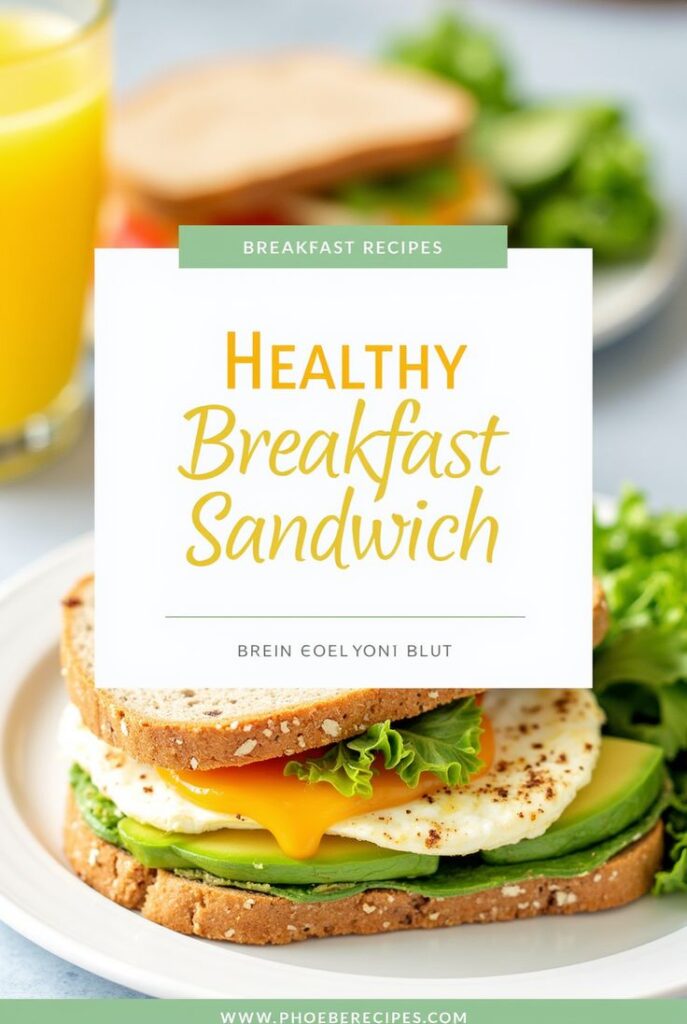Quick & Easy Healthy Breakfast Sandwiches: A Meal Prep Guide for Busy Mornings
Did you know healthy breakfast sandwiches can be made in just 20 minutes and stored in your freezer for up to 3 months?
Mornings are chaotic for most of us, but that doesn’t mean nutrition should take a backseat. With each sandwich packing approximately 226 calories, 15 grams of protein, and 8 grams of fat, these balanced meal prep breakfast sandwiches are the perfect solution for hectic weekdays. In fact, you can prepare a substantial batch using just 12 eggs, 6 slices of bacon, and 12 English muffins that will last in your refrigerator for 4-5 days. Additionally, if you’re looking for healthy breakfast sandwich ideas, options like high-fiber whole grain English muffins or gluten-free sourdough bread can elevate both nutrition and flavor.
We’ve been relying on easy breakfast meal prep to transform our mornings, and now we’re sharing our best tips with you. From quick 10-minute assembly to creative ways to use ingredients like creamy herbed goat cheese or fresh arugula, this guide will help you start your day right without sacrificing precious time.
Choose Your Ingredients Wisely
The foundation of truly delicious meal prep breakfast sandwiches begins with selecting high-quality ingredients that balance nutrition, flavor, and convenience. Your ingredient choices will significantly impact both taste and nutritional value, making this step crucial for success.
Egg options: whole, whites, or plant-based
Eggs provide essential protein and healthy fats for your morning meal. Whole eggs deliver approximately 6 grams of protein each and contain valuable nutrients like choline for brain health. Alternatively, liquid egg whites offer a lower-calorie option with approximately 3 tablespoons equaling one whole egg.
For plant-based eaters, several excellent alternatives exist. Tofu “eggs” create a remarkably similar texture—simply slice firm tofu about half an inch thick and season with turmeric for color and kala namak (black salt) for authentic egg flavor. Furthermore, chickpea flour creates protein-rich “eggs” that provide beneficial soluble fiber for regulating blood cholesterol levels.
Protein choices: sausage, bacon, or tofu
Amplify your sandwich’s protein content with strategic additions. Chicken or turkey sausage patties offer leaner alternatives to traditional pork—brands like Applegate provide options at just 60 calories per patty. Bacon enthusiasts might consider turkey bacon for reduced fat content or crispy tempeh bacon for a plant-based option rich in probiotics from fermentation.
Beyond these options, consider incorporating:
- Canadian bacon or ham slices for a leaner protein source
- Smoky tofu strips marinated in liquid smoke and maple syrup
- Plant-based breakfast sausage made from walnuts
Bread varieties: English muffins, bagels, or gluten-free
Your bread choice forms the foundation of your sandwich. Whole grain English muffins remain a popular option with those tiny nooks perfect for capturing melted cheese and egg juices. Consequently, many professional chefs prefer them for their ideal bread-to-filling ratio.
Bagels provide a heartier alternative—particularly whole grain or Ezekiel varieties that offer higher fiber content. Meanwhile, those avoiding gluten can select gluten-free English muffins, brown rice varieties found in freezer sections, or even gluten-free sourdough bread slices.
Cheese and seasoning ideas
Cheese adds creamy texture and satisfying flavor. American cheese melts exceptionally well due to sodium citrate, making it ideal for breakfast sandwiches. However, experiment with options like cheddar for sharp flavor, goat cheese for tanginess, or vegan alternatives like Violife or Chao for dairy-free versions.
Elevate flavor with creative seasonings—try everything bagel seasoning on egg whites, chives and garlic in a goat cheese spread, or black salt (kala namak) on plant-based eggs. Importantly, fresh herbs like rosemary not only enhance flavor but also provide antioxidants that support immune function.
Step-by-Step: How to Make Healthy Breakfast Sandwiches
Creating your own healthy breakfast sandwiches is straightforward once you understand the basic techniques. Let me walk you through the process that transforms simple ingredients into satisfying morning meals.
Bake or cook your eggs
The secret to perfect meal prep breakfast sandwiches starts with properly cooked eggs. Preheat your oven to 350°F and choose one of these methods:
- Donut pan method: Spray a donut pan with cooking spray, pour 1/3 cup egg whites or beaten eggs into each opening, and sprinkle with seasoning. This creates perfectly round eggs that fit English muffins exactly.
- Sheet pan method: Whisk eggs with milk and seasonings, then pour into a greased baking sheet lined with parchment paper. Bake until just set—about 15-25 minutes depending on pan size.
- Casserole dish approach: Pour egg mixture into a greased 9×13 baking dish and bake until center is just barely set.
Remember, slightly undercook your eggs as they’ll continue cooking during reheating.
Prepare meats and veggies
While eggs bake, simultaneously prepare your proteins and vegetables:
First, sauté onions until softened (about 5 minutes), then add spinach and cook until wilted (2-3 minutes). For bacon or sausage, cook according to package directions. Pre-cooked protein options save valuable time.
Toast and layer your bread
Split open English muffins and arrange them to create an assembly line. For extra flavor, brush with butter before toasting. Place muffins cut-side up on a baking sheet and toast until edges turn golden.
Assemble with cheese and extras
Initially place eggs on the bottom half of each English muffin. Next, add protein (sausage patty, bacon, or vegetarian alternative), followed by a slice of cheese. The heat from freshly cooked eggs helps melt the cheese naturally.
For meal prep, allow components to cool before assembly to prevent soggy bread. Once assembled, wrap each sandwich individually in parchment paper followed by foil for maximum freshness.
Meal Prep and Storage Tips
With your sandwiches assembled, proper storage becomes the key to maintaining freshness and flavor. Following these tested methods ensures your healthy breakfast sandwiches remain delicious whenever you’re ready to enjoy them.
How to wrap and store in fridge
For short-term storage, wrap each sandwich individually in parchment paper or foil before placing in an airtight container or zip-lock bag. This method keeps sandwiches fresh in the refrigerator for 4-5 days, though some sources suggest they’ll remain good for up to 7 days.
Essential tip: Ensure sandwiches are completely cool before wrapping to prevent unwanted moisture and soggy bread.
For refrigerator storage, a single layer of wrapping material works effectively. I’ve found parchment paper particularly helpful as it helps maintain proper moisture levels when reheating later.
Freezing instructions for long-term storage
For meal prep breakfast sandwiches you won’t eat within the week, freezing extends their lifespan substantially:
- Wrap each cooled sandwich individually in parchment paper, wax paper, or aluminum foil
- Place wrapped sandwiches in a freezer-safe resealable bag
- Remove as much air as possible to prevent freezer burn
- Store in freezer for up to 3 months
For maximum protection against freezer burn, consider double-wrapping: first with plastic wrap, then with aluminum foil. This extra layer especially helps when storing sandwiches for extended periods.
Labeling and organizing for easy access
Afterward, label each sandwich clearly, specifically if you’ve made different varieties. Using a permanent marker, write the contents and date directly on the wrapping or on the storage bag.
Organization becomes particularly important when preparing multiple sandwich types. For instance, if using different proteins or bread alternatives, create separate labeled freezer bags for each variety. This system allows for quick identification of your healthy breakfast sandwich options without unwrapping each one.
Essentially, proper labeling transforms your freezer into an organized meal prep station, making your morning routine effortless regardless of how busy your schedule becomes.
Reheating and Serving Suggestions
Properly reheating your meal prep breakfast sandwiches transforms them from good to great. Rather than settling for a soggy, unevenly heated breakfast, follow these methods to enjoy restaurant-quality results at home.
Microwave vs. oven vs. toaster oven
For microwave reheating from the refrigerator, unwrap your sandwich and place it on a microwave-safe plate with a paper towel underneath. Heat for approximately 1 minute until warmed through. The paper towel absorbs melting ice crystals, preventing soggy bread.
From frozen, first unwrap the sandwich and rewrap in a paper towel. Microwave on defrost (50% power) for 1 minute, then flip and heat on full power for 30-60 seconds until the cheese melts.
Alternatively, the oven produces superior results for crispy textures. Preheat to 350°F, wrap sandwiches in aluminum foil, and bake refrigerated sandwiches for 10-15 minutes or frozen ones for 20-25 minutes.
My favorite method combines both: microwave briefly to thaw, then finish in a toaster oven for crispy edges. Moreover, separating and toasting the English muffin top adds fresh crunch to the sandwich.
Add-ons like avocado, hot sauce, or greens
Fresh toppings added after reheating elevate your healthy breakfast sandwiches considerably. Try:
- Smashed avocado for creamy texture and healthy fats
- Sriracha or hot sauce for a morning kick
- Fresh leafy greens and ripe tomato for a perfectly balanced breakfast
Importantly, these fresh elements contrast beautifully with the warm, melty sandwich components.
Pairing ideas: fruit, yogurt, or smoothies
Complete your morning meal by pairing your sandwich with complementary sides:
- A simple arugula or mixed greens salad with light vinaigrette
- Fresh seasonal fruit for added fiber and vitamins
- Greek yogurt for additional protein
- A small smoothie for extra nutrients
Above all, remember that coffee makes the perfect companion to these hearty breakfast sandwiches. Generally, these pairings create a nutritionally complete breakfast that sustains energy throughout your morning.
Conclusion
Making healthy breakfast sandwiches ahead of time truly transforms chaotic mornings into smooth, stress-free experiences. Throughout this guide, we’ve explored how simple ingredients like eggs, quality proteins, and whole grain breads combine to create nutritious grab-and-go options with impressive staying power.
First and foremost, these sandwiches deliver approximately 226 calories and 15 grams of protein per serving, making them balanced fuel for busy days. Additionally, the customization possibilities seem endless—from plant-based alternatives to gluten-free options, everyone can find their perfect breakfast match.
The preparation process remains straightforward yet effective. Batch cooking eggs, preparing proteins, and assembling sandwiches takes merely 20 minutes but yields breakfasts for days or even months when properly stored. Consequently, you’ll save both time and money while eating better than ever.
Storage solutions deserve equal attention. Proper wrapping techniques allow sandwiches to last 4-5 days refrigerated or up to 3 months frozen. Therefore, you can prepare as many as your schedule demands without fear of waste.
Last but certainly not least, reheating methods matter tremendously. Whether you choose microwave speed or oven crispness, these sandwiches can taste freshly made any day of the week. Paired with fresh additions like avocado or a side of fruit, they create complete meals that fuel your body properly.
After all, breakfast shouldn’t be sacrificed just because life gets busy. These meal prep breakfast sandwiches prove that health, convenience, and flavor can coexist perfectly on your plate—even on the most hectic mornings.
FAQs
Q1. How long can I store meal prepped breakfast sandwiches? You can store meal prepped breakfast sandwiches in the refrigerator for 4-5 days. If you want to keep them longer, you can freeze them for up to 3 months. Just make sure to wrap them properly to maintain freshness.
Q2. What’s a quick way to reheat breakfast sandwiches? The quickest way to reheat a breakfast sandwich is in the microwave. For refrigerated sandwiches, heat for about 1 minute. For frozen ones, use the defrost setting for 1 minute, then flip and heat on full power for 30-60 seconds until the cheese melts.
Q3. Can I make healthy breakfast sandwiches at home? Absolutely! You can create nutritious breakfast sandwiches using ingredients like whole grain English muffins, egg whites, lean proteins like turkey bacon, and adding vegetables. These homemade sandwiches can provide a balanced meal with around 226 calories and 15 grams of protein.
Q4. What are some good add-ons for breakfast sandwiches? Fresh add-ons can elevate your breakfast sandwich. Try adding smashed avocado for healthy fats, hot sauce for a kick, or fresh leafy greens and tomato for extra nutrients. These additions can be put on after reheating for the best taste and texture.
Q5. Are there vegetarian options for breakfast sandwiches? Yes, there are many vegetarian options for breakfast sandwiches. You can use plant-based eggs made from tofu or chickpea flour, vegetarian sausage made from walnuts, or tempeh bacon. Pair these with vegan cheese alternatives for a completely plant-based sandwich.


